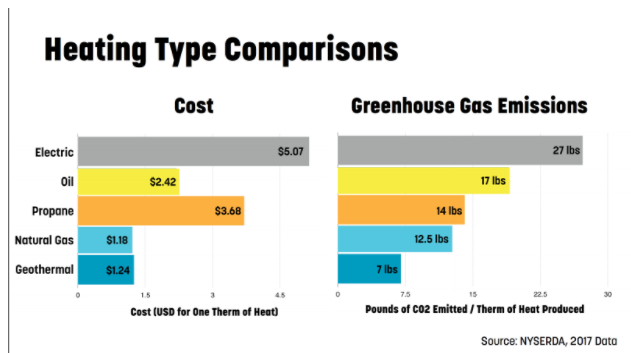What’s Dandelion?
Heating and cooling your home is an enormous cost for a service most of us can’t live without driven largely by technology that hasn’t changed much in several decades. The average U.S. household spends about $320 a month on utilities, most of which are allocated toward heating and cooling. That’s barely less than the $334 a month they spend on groceries.
This is the kind of stuff just begging for a change.
Collaborative Fund recently ed Dandelion Energy’s recent seed round. Below is a short interview with CEO Kathy Hannun on what the company does and where it’s going in the future.
Explain what Dandelion does to someone who’s unfamiliar.
Dandelion sells home geothermal heating and cooling systems. This system is made up of a “heat pump,” a powerful machine that sits inside of the home (where the home’s furnace used to be) and “ground loops,” a loop of pipes that go vertically down for a couple hundred feet in a homeowner’s yard.
A “Heat pump” does exactly what it’s name suggests: it uses electricity to pump heat from one place to another. A refrigerator is an everyday example. To keep your food and drinks cold, your fridge uses electricity to pump heat from the inside of the refrigerator out into your kitchen. This is why, if you put your hand on the vents of the fridge near the floor, you can feel warm air coming out.
A geothermal heat pump works like a powerful refrigerator, with a special power: it’s reversible! In the summer, when you want your home nice and cool, it pumps heat from the inside of your home into the earth; in the winter, when you want your home warm and toasty, the pump moves heat from the earth into your home. In order to pump heat to and from the earth, the heat pump needs some way of connecting to the earth. That’s what the ground loops are for.
The ground loops are U-shaped plastic pipes, inserted 300-500 feet into the ground, that are used to exchange heat between your house and the earth.
In the wintertime, water circulating through the ground loops absorbs heat from the earth, which is used to warm your home, and in the summertime your home is cooled by transferring the heat from your home into the earth.
Geothermal climate control has been known about for literally thousands of years. What’s changed? Why now?
People have been taking advantage of the fact that the earth maintains a stable temperature for home heating and cooling since the cavemen days. The reason people built their homes in caves was because a cave is surrounded by earth, and the earth acts as an insulator, keeping these dwellings at a much milder temperature year round than the air outside. You might call this passive geothermal heating and cooling, “passive” because while the earth moderates the temperature of the dwelling, without a heat pump there was no way for cavemen to adjust the temperature. They were forced to “just put on a sweater” and deal with it.
Geothermal heating and cooling for modern homes using heat pumps began in the mid 1900s and gained popularity in Sweden in the 1970s. Today in Sweden, about one third of homes use geothermal; it’s a mainstream way to heat and cool and it works great. In the US, while tens of thousands of geothermal heating and cooling systems are installed each year, they remain out of reach for most homeowners because of the high upfront installation cost. This is a shame because, once installed, these systems are often the lowest cost, most reliable and clean systems available.
Dandelion has developed a way to install geothermal heating and cooling systems cost effectively, using new technologies and equipment that makes the installation of the ground loops faster and less disruptive to the yard, as well as via the standardization of the system. Every system comes with a smart thermostat, giving today’s homeowners a level of control over their home comfort that cavemen could have only dreamed of.
The energy spike in 2007 and 2008 woke people up. But energy prices have plunged over the last five years. There’s two dangers here: The first of not being prepared when prices spike, the second is being lulled into complacency when prices are low. How much of Dandelion’s allure is locking in energy costs for the long-term?
Dandelion’s primary allure varies from homeowner to homeowner: some appreciate that the system delivers central A/C; some the escape from heating fuel deliveries; others the system’s health and safety benefits.
That said, locking in heating costs for the long term is highly beneficial, especially given today’s low oil prices.
Across the world, we’ve seen many homeowners installing rooftop solar to hedge against the possibility of rising electricity prices. Electricity prices are much less volatile than fuel prices. The fact that so many homeowners elect to take electricity prices into their own hands using solar suggests many will find value in doing so for fuel, a more volatile product that’s more expensive for many homeowners than electricity.
How big is this opportunity for the economy and for the environment?
Buildings account for almost a third of final energy consumption globally and are an equally important source of CO2 emissions. Currently, both space heating and cooling as well as hot water are estimated to account for roughly half of global energy consumption in buildings. These end-uses represent significant opportunities to reduce energy consumption, improve energy security and reduce CO2 emissions due to the fact that space and water heating provision is dominated by fossil fuels while cooling demand is growing rapidly in countries with very carbon-intensive electricity systems”. (source)
Low/zero-carbon and energy-efficient heating and cooling technologies for buildings have the potential to reduce CO2 emissions by up to 2 gigatonnes (Gt) and save 710 million tonnes oil equivalent (Mtoe) of energy by 2050. (source)
